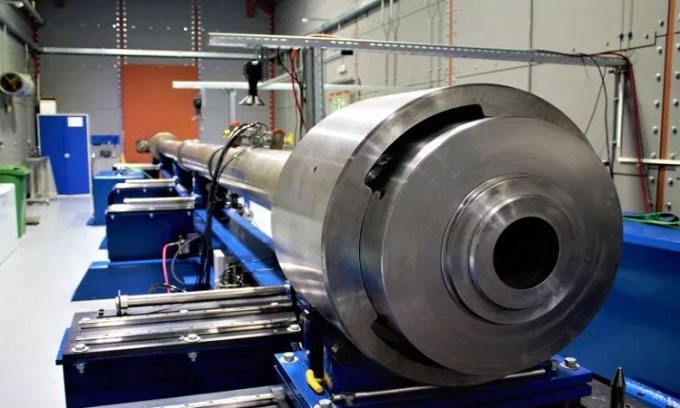First Light Fusion is testing a 22-meter-long gun that can simulate the fusion reactions occurring in the cores of stars.
The Big Friendly Gun (BFG) is a prototype of the technology that First Light Fusion in the UK hopes will revolutionize the future of the energy production industry. In a recent experiment at the company’s facility, researchers monitored data from the gun from a safe distance, separated by a thick concrete wall. Each test firing brings the company closer to its goal of creating a limitless source of clean energy, Newsweek reported on October 28.

The 22-meter-long Big Friendly Gun (BFG). (Photo: First Light Fusion)
This massive steel gun operates by propelling a piston at high speed using 3 kilograms of gunpowder. As it moves through the barrel, the piston compresses hydrogen gas, entering a conical section that compresses the gas to an extremely small point before detonating through a metal membrane. This process fires a projectile at a speed of 6.9 km/s through a vacuum chamber. There, the projectile collides with fusion fuel, temporarily creating conditions for nuclear fusion to occur. First Light Fusion stated that they were tasked with designing and building the machine at a cost of $1.27 million over more than 10 months.
The process of atomic nuclear fusion is the same process that powers the Sun, and scientists have been trying to replicate it on Earth for nearly 100 years because this reaction produces more energy than fossil fuels without emitting carbon or radioactive byproducts. Additionally, the fuel needed for the reaction (typically hydrogen isotopes like deuterium and tritium) can be produced artificially. If harnessed, fusion energy could provide a vast source of clean energy.
First Light Fusion’s approach may be very different from the more complex and popular tokamak method, which uses massive magnets to circulate plasma. However, if successful, Nick Hawker, the company’s CEO, believes this method could transform the energy production sector.
After years of research on tokamak technology, the main issue has been how plasma dissipates energy. Scientists have found that energy within plasma often leaks through magnetic field lines. Currently, no facility has generated more energy than is required to operate a tokamak. Another significant challenge is the intensity of the fusion reaction. A tokamak must circulate plasma at temperatures of 100 million degrees Celsius to produce fusion. Neutrons from the reaction collide with the walls of the containment chamber. First Light Fusion’s reactor is designed to address this issue by lining the chamber with a liquid that absorbs neutrons, thereby reducing the bombardment of the steel structure compared to tokamak reactors.
The BFG is just a stepping stone toward the ultimate goal. The company is developing the next machine, the M3, which includes multiple capacitors and uses electric current to propel the projectile at 20 km/s. Hawker hopes that the First Light Fusion reactor can produce commercial electricity by the 2030s and supply the power grid in the following decade.


















































